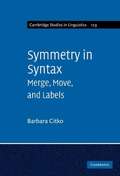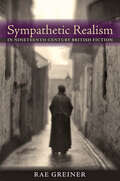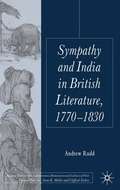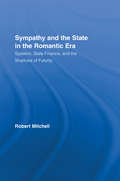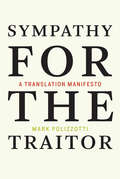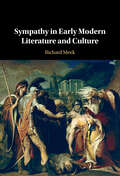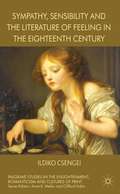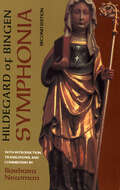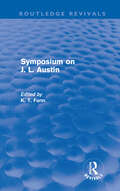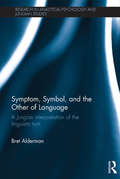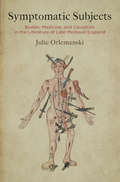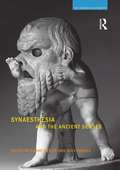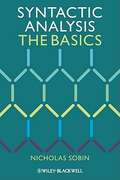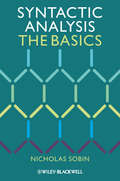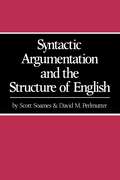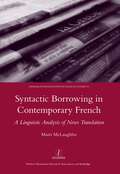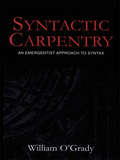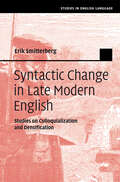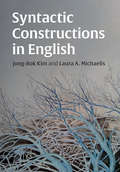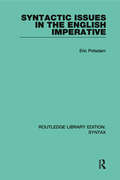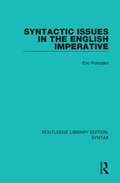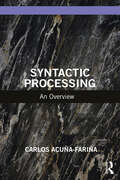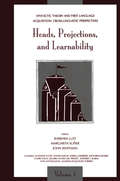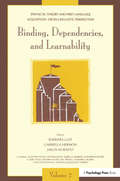- Table View
- List View
Symmetry in Syntax
by Barbara CitkoWhile much has been written on asymmetric aspects of sentence structure, symmetric aspects have been largely ignored, or claimed to be non-existent. Does symmetry in syntax exist, and if it does, how do we account for it? Barbara Citko sets out to tackle these questions and offers a unified approach to a number of phenomena that have so far been studied only in isolation. Focusing on three core minimalist mechanisms: merge, move and labeling, she advances a new theory of these mechanisms, by showing that under certain well-defined circumstances merge can create symmetric structures, move can target either of two potentially moveable objects, and labels can be constructed symmetrically from the features of two objects. This book is aimed at researchers and graduate students interested in minimalist syntax, the structure of questions, relative clauses, coordination, double object constructions and copular sentences.
Sympathetic Realism in Nineteenth-Century British Fiction
by Rae GreinerBritish realist novelists of the nineteenth century viewed sympathy not as a feeling but as a form of imaginative thinking useful in constructing their fiction.Rae Greiner proposes that sympathy is integral to the form of the classic nineteenth-century realist novel. Following the philosophy of Adam Smith, Greiner argues that sympathy does more than foster emotional identification with others; it is a way of thinking along with them. By abstracting emotions, feelings turn into detached figures of speech that may be shared. Sympathy in this way produces realism; it is the imaginative process through which the real is substantiated.In Sympathetic Realism in Nineteenth-Century British Fiction Greiner shows how this imaginative process of sympathy is written into three novelistic techniques regularly associated with nineteenth-century fiction: metonymy, free indirect discourse, and realist characterization. She explores the work of sentimentalist philosophers David Hume, Adam Smith, and Jeremy Bentham and realist novelists Jane Austen, Charles Dickens, George Eliot, Joseph Conrad, and Henry James.
Sympathy and India in British Literature, 1770–1830
by Andrew RuddIndia was the object of intense sympathetic concern during the Romantic period. But what was the true nature of imaginative engagement with British India? This study explores how a range of authors, from Edmund Burke and Sir William Jones to Robert Southey and Thomas Moore, sought to come to terms with India's strangeness and distance from Britain.
Sympathy and the State in the Romantic Era: Systems, State Finance, and the Shadows of Futurity (Routledge Studies in Romanticism #8)
by Robert MitchellSympathy and the State in the Romantic Era explores a fascinating connection between two seemingly unrelated Romantic-era discourses, outlining the extent to which eighteenth and early nineteenth century theories of sympathy were generated by crises of state finance. Through readings of authors such as David Hume, Adam Smith, William Wordsworth, and P.B. Shelley, this volume establishes the ways in which crises of state finance encouraged the development of theories of sympathy capable of accounting for both the fact of "social systems" as well as the modes of emotional communication by means of which such systems bound citizens to one another. Employing a methodology that draws on the systems theory of Niklas Luhmann, Michel Serres, and Giovanni Arrighi, as well as Gilles Deleuze’s theories of time and affect, this book argues that eighteenth and early nineteenth century philosophies of sympathy emerged as responses to financial crises. Individual chapters focus on specific texts by David Hume, Adam Smith, Jean-Jacques Rousseau, Ann Yearsley, William Wordsworth, and P.B. Shelley, but Mitchell also draws on periodicals, pamphlets, and parliamentary hearings to make the argument that Romantic era theories of sympathy developed new discourses about social systems intended both to explain, as well as contain, the often disruptive effects of state finance and speculation.
Sympathy for the Traitor: A Translation Manifesto (The\mit Press Ser.)
by Mark PolizzottiAn engaging and unabashedly opinionated examination of what translation is and isn't.For some, translation is the poor cousin of literature, a necessary evil if not an outright travesty—summed up by the old Italian play on words, traduttore, traditore (translator, traitor). For others, translation is the royal road to cross-cultural understanding and literary enrichment. In this nuanced and provocative study, Mark Polizzotti attempts to reframe the debate along more fruitful lines. Eschewing both these easy polarities and the increasingly abstract discourse of translation theory, he brings the main questions into clearer focus: What is the ultimate goal of a translation? What does it mean to label a rendering “faithful”? (Faithful to what?) Is something inevitably lost in translation, and can something also be gained? Does translation matter, and if so, why? Unashamedly opinionated, both a manual and a manifesto, his book invites usto sympathize with the translator not as a “traitor” but as the author's creative partner.Polizzotti, himself a translator of authors from Patrick Modiano to Gustave Flaubert, explores what translation is and what it isn't, and how it does or doesn't work. Translation, he writes, “skirts the boundaries between art and craft, originality and replication, altruism and commerce, genius and hack work.” In Sympathy for the Traitor, he shows us how to read not only translations but also the act of translation itself, treating it not as a problem to be solved but as an achievement to be celebrated—something, as Goethe put it, “impossible, necessary, and important.”
Sympathy in Early Modern Literature and Culture
by Richard MeekThis is the first comprehensive study of sympathy in the early modern period, providing a deeply researched and interdisciplinary examination of its development in Anglophone literature and culture. It argues that the term sympathy was used to refer to an active and imaginative sharing of affect considerably earlier than previous critical and historical accounts have suggested. Investigating a wide range of texts and genres, including prose fiction, sermons, poetic complaint, drama, political tracts, and scientific treatises, Richard Meek demonstrates the ways in which sympathy in the period is bound up with larger debates about society, religion, and identity. He also reveals the extent to which early modern emotions were not simply humoral or grounded in the body, but rather relational, comparative, and intertextual. This volume will be of particular interest to scholars and students of Renaissance literature and history, the history of emotions, and the history and philosophy of science.
Sympathy, Sensibility and the Literature of Feeling in the Eighteenth Century
by Ildiko CsengeiWhat makes it possible for self-interest, cruelty and violence to become part of the benevolent, compassionate ideology of eighteenth-century sensibility? This book explores forms of emotional response, including sympathy, tears, swoons and melancholia through a range of eighteenth-century literary, philosophical and scientific texts.
Symphonia: A Critical Edition of the "Symphonia Armonie Celestium Revelationum" (Symphony of the Harmony of Celestial Revelations)
by Hildegard of BingenFor this revised edition of Hildegard's liturgical song cycle, Barbara Newman has redone her prose translations of the songs, updated the bibliography and discography, and made other minor changes. Also included is an essay by Marianne Richert Pfau which delineates the connection between music and text in the Symphonia.Famous throughout Europe during her lifetime, Hildegard of Bingen (1098-1179) was a composer and a poet, a writer on theological, scientific, and medical subjects, an abbess, and a visionary prophet. One of the very few female composers of the Middle Ages whose work has survived, Hildegard was neglected for centuries until her liturgical song cycle was rediscovered. Songs from it are now being performed regularly by early music groups, and more than twenty compact discs have been recorded.
Symposium on J. L. Austin (Routledge Revivals)
by K T FannJ. L. Austin (1911-1960) exercised in Post-war Oxford an intellectual authority similar to that of Wittgenstein in Cambridge. Although he completed no books of his own and published only seven papers, Austin became through lectures and talks one of the acknowledged leaders in what is called ‘Oxford philosophy’ or ‘ordinary language philosophy’. Few would dispute that among analytic philosophers Austin stands out as a great and original philosophical genius. Three volumes of his writing, published after his death, have become classics in analytical philosophy: Philosophical Papers; Sense and Sensibilia; and How to Do Things with Words. First published in 1969, this book is a collection of critical essays on Austin’s philosophy written by well-known philosophers, many of whom knew Austin personally. A number of essays included were especially written for this volume, but the majority have appeared previously in various journals or books, not all easy to obtain.
Symptom, Symbol, and the Other of Language: A Jungian Interpretation of the Linguistic Turn (Research in Analytical Psychology and Jungian Studies)
by Bret AldermanEvery statement about language is also a statement by and about psyche. Guided by this primary assumption, and inspired by the works of Carl Jung, in Symptom, Symbol, and the Other of Language, Bret Alderman delves deep into the symbolic and symptomatic dimensions of a deconstructive postmodernism infatuated with semiotics and the workings of linguistic signs. This book offers an important exploration of linguistic reference and representation through a Jungian understanding of symptom and symbol, using techniques including amplification, dream interpretation, and symbolic attitude. Focusing on Ferdinand de Saussure, Jacques Derrida, Michel Foucault, and Richard Rorty, Alderman examines the common belief that words and their meaning are grounded purely in language, instead envisioning a symptomatic expression of alienation and collective dissociation. Drawing upon the nascent field of ecopsychology, the modern disciplines of phenomenology and depth psychology, and the ancient knowledge of myth and animistic cosmologies, Alderman dares us to re-imagine some of the more sacrosanct concepts of the contemporary intellectual milieu informed by semiotics and the linguistic turn. Symptom, Symbol, and the Other of Language is essential reading for academics and students engaged in the study of depth psychology. However, the interdisciplinary approach of the work ensures that it will also be of great interest to those researching and studying in the areas of ethology, ecopsychology, philosophy, linguistics and mythology.
Symptomatic Subjects: Bodies, Medicine, and Causation in the Literature of Late Medieval England (Alembics: Penn Studies in Literature and Science)
by Julie OrlemanskiIn the period just prior to medicine's modernity—before the rise of Renaissance anatomy, the centralized regulation of medical practice, and the valorization of scientific empiricism—England was the scene of a remarkable upsurge in medical writing. Between the arrival of the Black Death in 1348 and the emergence of printed English books a century and a quarter later, thousands of discrete medical texts were copied, translated, and composed, largely for readers outside universities. These widely varied texts shared a model of a universe crisscrossed with physical forces and a picture of the human body as a changeable, composite thing, tuned materially to the world's vicissitudes. According to Julie Orlemanski, when writers like Geoffrey Chaucer, Robert Henryson, Thomas Hoccleve, and Margery Kempe drew on the discourse of phisik—the language of humors and complexions, leprous pustules and love sickness, regimen and pharmacopeia—they did so to chart new circuits of legibility between physiology and personhood.Orlemanski explores the texts of her vernacular writers to show how they deployed the rich terminology of embodiment and its ailments to portray symptomatic figures who struggled to control both their bodies and the interpretations that gave their bodies meaning. As medical paradigms mingled with penitential, miraculous, and socially symbolic systems, these texts demanded that a growing number of readers negotiate the conflicting claims of material causation, intentional action, and divine power. Examining both the medical writings of late medieval England and the narrative and poetic works that responded to them, Symptomatic Subjects illuminates the period's conflicts over who had the authority to construe bodily signs and what embodiment could be made to mean.
Synaesthesia and the Ancient Senses: Synaesthesia And The Ancient Senses (The Senses in Antiquity)
by Shane Butler Alex PurvesLike us, the ancient Greeks and Romans came to know and understand the world through their senses. Yet sensory experience has rarely been considered in the study of antiquity and, when the senses are examined, sight is regularly privileged. 'Synaesthesia and the Ancient Senses' presents a radical reappraisal of antiquity's textures, flavours, and aromas, sounds and sights. It offers both a fresh look at society in the ancient world and an opportunity to deepen the reading of classical literature. The book will appeal to readers in classical society and literature, philosophy and cultural history. All Greek and Latin is translated and technical matters are explained for the non-specialist. The introduction sets the ancient senses within the history of aesthetics and the subsequent essays explores the senses throughout the classical period and on to the modern reception of classical literature.
Syntactic Analysis: The Basics
by Nicholas SobinOffers a hands-on approach to understanding and performing syntactic analysis and introduces students to linguistic argumentation.
Syntactic Analysis: The Basics
by Nicholas SobinHighly readable and eminently practical, Syntactic Analysis: The Basics focuses on bringing students with little background in linguistics up to speed on how modern syntactic analysis works. A succinct and practical introduction to understanding sentence structure, ideal for students who need to get up to speed on key concepts in the field Introduces readers to the central terms and concepts in syntax Offers a hands-on approach to understanding and performing syntactic analysis and introduces students to linguistic argumentation Includes numerous problem sets, helpfully graded for difficulty, with model answers provided at critical points Prepares readers for more advanced work with syntactic systems and syntactic analyses
Syntactic Argumentation and the Structure of English
by Scott Soames David M. PerlmutterSyntactic Argumentation and the Structure of English (SASE) presents the major theoretical developments in generative syntax and the empirical arguments motivating them. Beautifully and lucidly written, it is an invaluable resource for working linguists as well as a pedagogical tool of unequaled depth and breadth. The chief focus of the book is syntactic argumentation. Beginning with the fundamentals of generative syntax, it proceeds by a series of gradually unfolding arguments to analyses of some of the most sophisticated proposals. It includes a wide variety of problems that guide the reader in constructing arguments deciding between alternative analyses of syntactic constructions and alternative theoretical formulations. Someone who has worked through the problems and arguments in this book will be able to apply the skills in argumentation it develops to novel issues in syntax. While teaching syntactic argumentation, SASE covers the major empirical results of generative syntax. Its contents include: 1) Transformations in single-clause sentences2) Complementation and multi-clause transformations3) Universal principles governing rule interaction: the cycle and strict cyclicity4) Movement rules5) Ross's constraints6) Pronominal reference and anaphora SASE is an important book for several different audiences:1) For students, it is an introduction to syntax that teaches argumentation as well as a wide range of empirical results in the field. 2) For linguists, it is a sourcebook of classical analyses and arguments, with some new arguments bearing on classical issues. 3) For scholars, teachers, and students in related fields, it is a comprehensive guide to the major empirical and theoretical developments in generative syntax. SASE contains enough material for a two-semester or three-quarler sequence in syntax. Because it assumes no previous background, it can be used as the main text in an introduction to syntax. Since it covers a wide range of material not available in other texts, it is also suitable for intermediate and advanced syntax courses and as a supplementary source in more specialized courses and courses in other disciplines. A storehouse of classical and original arguments, SASE will prove to be of lasting value to the teacher, the student, and researchers in both linguistics and related fields.
Syntactic Borrowing in Contemporary French: A Linguistic Analysis of News Translation
by Mairi MaLaughlinIt is widely held that the large-scale translation of international news from English will lead to changes in French syntax. For the first time this assumption is put to the test using extensive fieldwork carried out in an international news agency and a corpus of translated news agency dispatches. The linguistic analysis of three syntactic structures in the translations is complemented by an investigation of the effects of a range of factors including, most notably, the speed at which the translation is carried out. The analysis sheds new light on the ways in which news translation could lead to syntactic borrowing in French, and by extension, in other languages.
Syntactic Carpentry: An Emergentist Approach to Syntax
by William O'GradySyntactic Carpentry: An Emergentist Approach to Syntax presents a groundbreaking approach to the study of sentence formation. Building on the emergentist thesis that the structure and use of language is shaped by more basic, non-linguistic forces—rather than by an innate Universal Grammar—William O'Grady shows how the defining properties of various core syntactic phenomena (phrase structure, co-reference, control, agreement, contraction, and extraction) follow from the operation of a linear, efficiency-driven processor. This in turn leads to a compelling new view of sentence formation that subsumes syntactic theory into the theory of sentence processing, eliminating grammar in the traditional sense from the study of the language faculty. With this text, O'Grady advances a growing body of literature on emergentist approaches to language, and situates this work in a broader picture that also includes attention to key issues in the study of language acquisition, psycholinguistics, and agrammaticism. This book constitutes essential reading for anyone interested in syntax and its place in the larger enterprise of cognitive science.
Syntactic Change in Late Modern English: Studies on Colloquialization and Densification (Studies in English Language)
by Erik SmitterbergSyntactic Change in Late Modern English presents a stability paradox to linguists; despite the many social changes that took place between 1700 and 1900, the language appeared to be structurally stable during this period. This book resolves this paradox by presenting a new, idiolect-centred perspective on language change, and shows how this framework is applicable to change in any language. It then demonstrates how an idiolect-centred framework can be reconciled with corpus-linguistic methodology through four original case studies. These concern colloquialization (the process by which oral features spread to writing) and densification (the process by which meaning is condensed into shorter linguistic units), two types of change that characterize Modern English. The case studies also shed light on the role of genre and gender in language change and contribute to the discussion of how to operationalize frequency in corpus linguistics. This study will be essential reading for researchers in historical linguistics, corpus linguistics and sociolinguistics.
Syntactic Constructions in English
by Jong-Bok Kim Laura A. MichaelisConstruction grammar (CxG) is a framework for syntactic analysis that takes constructions - pairings of form and meaning that range from the highly idiomatic to the very general - to be the building blocks of sentence meaning. Offering the first comprehensive introduction to CxG to focus on both English words and the constructions that combine them, this textbook shows students not only what the analyses of particular structures are, but also how and why those analyses are constructed, with each chapter taking the student step-by-step through the reasoning processes that yield the best description of a data set. It offers a wealth of illustrative examples and exercises, largely based on real language data, making it ideal for both self-study and classroom use. Written in an accessible and engaging way, this textbook will open up this increasingly popular linguistic framework to anyone interested in the grammatical patterns of English.
Syntactic Islands
by Cedric BoeckxThe phenomenon of the syntactic 'island' – a clause or structure from which a word cannot be moved – is central to research and study in syntactic theory. This book provides a comprehensive overview of syntactic islands. What are they? How do they arise? Why do they exist? Cedric Boeckx discusses the pros and cons of all the major generative accounts of island effects, and focuses the discussion on whether islands are narrowly syntactic effects, are due to interface factors or are 'merely' performance effects. Thanks to the diversity of island effects, readers are given a unique opportunity to familiarize themselves with all the major research styles and types of analysis in theoretical linguistics and have the chance to reflect on the theoretical implications of concrete natural language examples, allowing them to develop their own synthesis.
Syntactic Issues in the English Imperative (Outstanding Dissertations in Linguistics #20)
by Eric PotsdamFirst Published in 1998. This work is an unrevised version of my 1996 University of California, Santa Cruz Ph.D. dissertation. The only changes that have been made are corrections of typographical errors, minor rewording, updating of references, and the inclusion of an index. I would like to thank Rosemary Plapp and Kristi Long for help with proofreading and preparation of the manuscript.
Syntactic Issues in the English Imperative (Routledge Library Editions: Syntax #20)
by Eric PotsdamThis study, first published in 1998, provides a close investigation of central syntactic issues in the English imperative clause type. It argues that the imperative has largely regular syntactic behaviour within a conventional conception of English clause structure. This title will be of interest to students of language and linguistics.
Syntactic Processing: An Overview
by Carlos Acuña-FariñaThis book provides an overview of the structures, topics and main theories of syntactic processing. It covers the last 40 years of sentence-level psycholinguistic research and debates and makes it accessible to both theoretical linguists and experimental psychologists. Tying linguistically relevant issues to psycholinguistic theory, this book: Covers the processing of the grammatical phenomena adjunction, agreement and gap filling and discusses the relationship between grammars and parsers Discusses experimental work and theories, demonstrating how psychologists have made real strides in understanding language and how studying the processing of syntactic structure is the same as studying the nature of language Explores the key theories of psycholinguistics, including recent developments Explains the different methodologies of sentence processing, such as eye-tracking and electroencephalography Bridging the gap between psycholinguistic research and the study of language, this book is essential reading for advanced students and scholars of linguistics and experimental psycholinguistics as well as cognitive science and psychology.
Syntactic Theory and First Language Acquisition: Cross-linguistic Perspectives -- Volume 1: Heads, Projections, and Learnability -- Volume 2: Binding, Dependencies, and Learnability
by John Whitman Claire Foley Suzanne Flynn Barbara Lust Margarita Suñer Shyam Kapur Isabella Barbier Katharina Boser Zelmira Nuñez del Prado Edward J. Rubin Lynn Santelmann Almeida Jacqueline ToribioUniversal Grammar (UG) is a theory of both the fundamental principles for all possible languages and the language faculty in the "initial state" of the human organism. These two volumes approach the study of UG by joint, tightly linked studies of both linguistic theory and human competence for language acquisition. In particular, the volumes collect comparable studies across a number of different languages, carefully analyzed by a wide range of international scholars. The issues surrounding cross-linguistic variation in "Heads, Projections, and Learnability" (Volume 1) and in "Binding, Dependencies, and Learnability" (Volume 2) are arguably the most fundamental in UG. How can principles of grammar be learned by general learning theory? What is biologically programmed in the human species in order to guarantee their learnability? What is the true linguistic representation for these areas of language knowledge? What universals exist across languages? The two volumes summarize the most critical current proposals in each area, and offer both theoretical and empirical evidence bearing on them. Research on first language acquisition and formal learnability theory is placed at the center of debates relative to linguistic theory in each area. The convergence of research across several different disciplines -- linguistics, developmental psychology, and computer science -- represented in these volumes provides a paradigm example of cognitive science.
Syntactic Theory and First Language Acquisition: Cross-linguistic Perspectives -- Volume 1: Heads, Projections, and Learnability -- Volume 2: Binding, Dependencies, and Learnability
by Claire Foley Suzanne Flynn Jaklin Kornfilt Barbara Lust Shyam Kapur Isabella Barbier Katharina Boser Zelmira Nuñez del Prado Edward J. Rubin Lynn Santelmann Gabriella Hermon Jacqueline ToribioUniversal Grammar (UG) is a theory of both the fundamental principles for all possible languages and the language faculty in the "initial state" of the human organism. These two volumes approach the study of UG by joint, tightly linked studies of both linguistic theory and human competence for language acquisition. In particular, the volumes collect comparable studies across a number of different languages, carefully analyzed by a wide range of international scholars. The issues surrounding cross-linguistic variation in "Heads, Projections, and Learnability" (Volume 1) and in "Binding, Dependencies, and Learnability" (Volume 2) are arguably the most fundamental in UG. How can principles of grammar be learned by general learning theory? What is biologically programmed in the human species in order to guarantee their learnability? What is the true linguistic representation for these areas of language knowledge? What universals exist across languages? The two volumes summarize the most critical current proposals in each area, and offer both theoretical and empirical evidence bearing on them. Research on first language acquisition and formal learnability theory is placed at the center of debates relative to linguistic theory in each area. The convergence of research across several different disciplines -- linguistics, developmental psychology, and computer science -- represented in these volumes provides a paradigm example of cognitive science.
